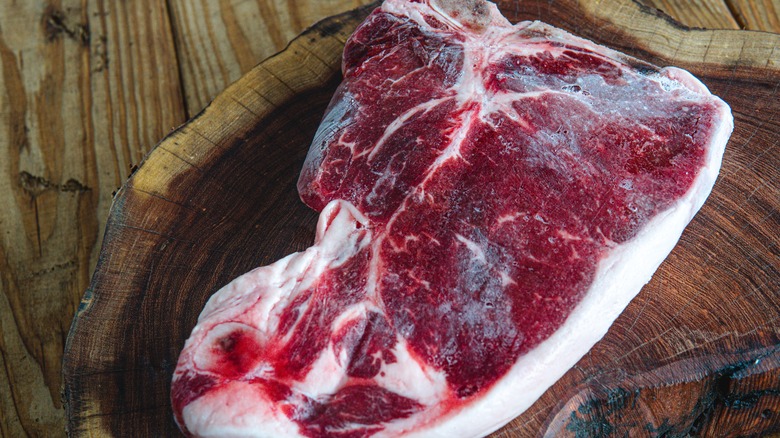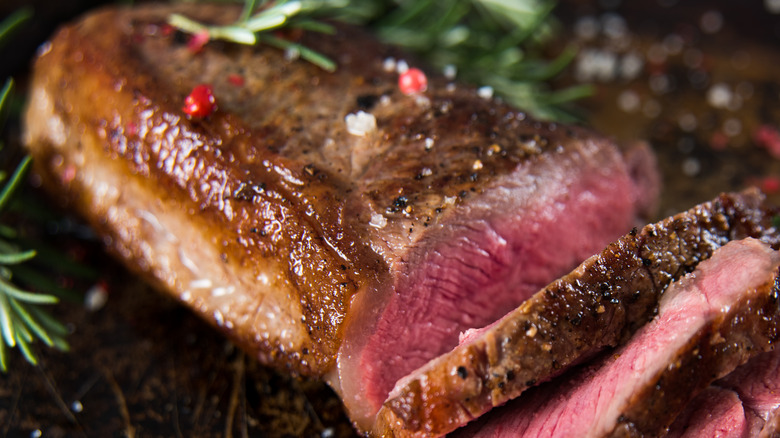Alton Brown's Perfect Steak Starts Out Frozen
Dinner at a steakhouse has always been a special occasion, but as food inflation continues to force consumers to tighten their budgets, perfecting your favorite cut at home is more important now than ever. While any home cook can get it right occasionally, celebrity chef Alton Brown breaks down the scientific reasons behind his perfectly cooked steaks into an equation we can consistently follow.
Home cooks should employ different cooking methods for each variety of meat depending on the cut, amount of fat, and thickness. Although unorthodox, Brown starts with a frozen steak to achieve a perfectly juicy medium-rare sirloin steak with a golden crust, the carnivore's Holy Grail. Armed with a cast-iron skillet and a digital meat thermometer, Brown prefers to cook one-inch thick steaks in the oven using this foolproof method.
He starts by seasoning the raw meat with salt and placing it uncovered on a sheet pan. Brown adds a second pan on top of the steak and pops it into the freezer overnight. The weight of the top pan will keep the meat's thickness even, which gives you a consistent temperature throughout the cooked steak.
The beef can be frozen for up to two months but should be wrapped in parchment paper and sealed in a storage baggie first to prevent freezer burn. The salt coating is enough protection if making the steak the next day.
Frozen steak + cast iron griddle = perfection
The steaks should be removed from the freezer just before cooking and brushed with a neutral oil. Unlike traditional recipes that begin on the stove and are finished in the oven when the meat is over an inch thick, Brown cooks the frozen steak entirely in the oven on a cast-iron pan. The oven and pan are preheated to 500 degrees Fahrenheit for an hour with a rack set at the top for broiling. If your oven isn't clean, this will cause some smoking.
The steak should sizzle as soon as it touches the pan. Once in the oven, immediately turn the temperature to the highest broiler setting and cook the meat for about four minutes on both sides or until it reaches an internal temperature of 110 degrees, for medium-rare. For accuracy, check the temperature by inserting the thermometer from the side to the meat's center without touching a bone or fat.
Wrap the steak in aluminum foil (don't just tent it) and allow it to rest for ten minutes on a rimmed baking sheet to continue cooking. The resting meat will be juicy, so be careful when unwrapping it so you don't spill the jus. Slice the steak thinly on the bias and against the grain. Pour the accumulated juices on top or use them to make a pan sauce. If the steak is thicker than an inch, consider using the reverse-searing technique to achieve similar results.
The science behind this method
Cooking the steak on a flat surface, as opposed to a grill pan, means more of its surface area is in contact with the high temperature. Along with a dry exterior, this helps the steak develop an even, flavor-enhancing crust, whether frozen or not, thanks to the Maillard reaction. However, unexpectedly, freezing the meat can also prevent it from overcooking.
At 140 degrees Fahrenheit, the beef's muscle fibers shrink, releasing moisture, turning grey, and toughening. Since food cooks from the outside inward, the grey band around the meat indicates how much of it is overcooked. Cooking a steak from its frozen state allows the exterior to develop a crust but slows the interior cooking, resulting in juicier meat.
While a fresh steak would take less time to finish cooking in the oven, this technique gives home cooks the confidence, spur of the moment, to prepare perfectly cooked steak directly from the freezer. It is also more forgiving, giving them a larger window of time to achieve their preferred doneness.



